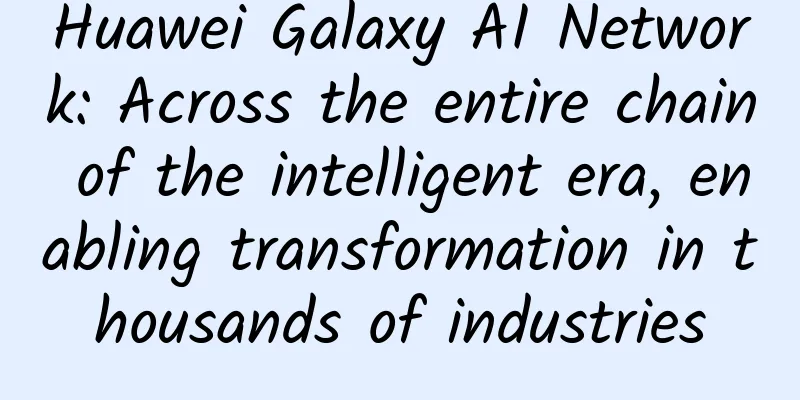Huawei Galaxy AI Network: Across the entire chain of the intelligent era, enabling transformation in thousands of industries

|
With the emergence of ChatGPT, we have entered a new era of AI with large models. This technological revolution is profoundly affecting all walks of life, and at the same time, it has also put forward new challenges and requirements for infrastructure. Among them, the network, as the core carrier of data circulation and wisdom transmission, is also facing new challenges. From computing power production to terminal applications, from data centers to campus networks, Huawei Galaxy AI Network has achieved intelligent connectivity across the entire chain of large models. With its innovative technical architecture and intelligent management strategies, Galaxy AI Network ensures the smooth flow of data and the effective release of computing power, providing a solid computing power backing for the industry and bringing users an excellent user experience. New challenges for network evolution in the era of big models The scale of model parameters has expanded dramatically, and network architecture is facing unprecedented challenges and innovation requirements. The Scaling Laws proposed by OpenAI reveal the power-law relationship between model performance and the amount of computation, number of parameters, and data size, and the network also needs to evolve synchronously to meet this trend. In this era, large models evolve rapidly on a daily basis, placing stringent requirements on data processing, network bandwidth, and latency control. Traditional network architectures are unable to cope with large model training and reasoning. Therefore, a network that can be flexibly expanded, intelligently scheduled, and efficiently coordinated has become the key infrastructure of this era. As the number of model parameters continues to increase, the amount of data that needs to be processed during training also grows exponentially. Therefore, the network architecture must be able to support ultra-large-scale networking capabilities and ensure seamless interconnection between thousands or even tens of thousands of GPUs. Secondly, large model training generates massive amounts of data, and both internal and external communications require high bandwidth support. GPU high-speed interconnection and load balancing optimization are key to ensuring data transmission speed and efficiency. Third, the training process of large models has extremely high requirements for the real-time performance of data, and any slight delay may have a significant impact on the training effect. Therefore, it is necessary to optimize the network architecture and congestion control, reduce delay and jitter, and ensure the continuity and efficiency of training. Fourth, large models have a long training cycle and low tolerance for faults, so the network needs to have ultra-high stability and fast fault recovery capabilities. Finally, large model clusters are large in scale and complex in configuration. Automated deployment and fault detection can improve system reliability and efficiency and reduce operation and maintenance costs. Huawei Galaxy AI Network is selected in Gartner report and stands out According to Gartner's latest "2024 Enterprise Network Technology Maturity Curve Report", AI training has unique requirements for the network environment, such as packet loss rate and data packet transmission, which are directly related to GPU computing efficiency. Although IB network technology can partially meet these requirements, Ethernet network solutions with open ecology and deep experience are more popular in the market. The 2024 Enterprise Network Technology Maturity Curve Report shows that AI Ethernet Fabric technology is in the embryonic stage of innovation and is expected to reach the peak of technological maturity in the next 2 to 5 years. Huawei was selected as a representative supplier in the field of AI Ethernet Fabric technology, becoming the only non-North American manufacturer selected in this field. This recognition not only highlights Huawei's leading position in AI network infrastructure, but also reflects its deep accumulation and successful practice in meeting the high-demand network environment for large model training. Zhao Zhipeng, Vice President of Huawei's Data Communication Product Line, pointed out that IP networks, as the cornerstone of the intelligent era, are responsible for efficiently transmitting massive amounts of data to computing centers, fully releasing computing potential, and delivering computing power to thousands of industries. To this end, Huawei launched the Net5.5G new generation network solution Galaxy AI Network for the intelligent era, focusing on the efficient release of computing power and efficient data transmission, accelerating the popularization of AI to thousands of industries, making computing power, intelligence and enterprises zero distance, and forming a new quality of productivity. Zhao Zhipeng, Vice President of Huawei's Data Communications Product Line Building a network foundation for the intelligent era In the era of big models, model manufacturers need to efficiently complete model training and quickly bring it to market. In this process, from model training to end-user application, every step is inseparable from efficient and stable network connection. The network, as the invisible link of this digital ecological chain, is of self-evident importance. It requires data center networks, wide area networks, campus networks and other links to work closely together to support the intelligent era. Huawei's Galaxy AI network solution is an all-round network foundation tailored to this demand. It not only covers key areas such as computing power production, transportation, terminal experience and security, but also conducts in-depth optimization and comprehensive upgrades in every link. Computing power production link: Large model training places almost stringent requirements on the network's low packet loss and high throughput capabilities. Huawei's Galaxy AI data center network provides a solid network foundation for model training with its support for ultra-large-scale clusters of millions of cards, as well as its ultra-high throughput, stability and reliability. Through the three core concepts of "one map" for intelligent operation and maintenance, "one network" for diversified computing power, and "one platform" for intelligent integration, the Galaxy AI network fully unleashes the powerful computing power potential of the AI era. Computing power transportation: After the computing power is produced, how to transport it to the end user efficiently and accurately is the next key challenge. Huawei Galaxy AI WAN realizes intelligent traffic analysis and scheduling of key nodes of the WAN through the innovative deployment of intelligent computing power cards, ensuring lossless computing power transmission across 2,000 kilometers, and providing highly deterministic network quality assurance for various applications. End-user experience: When computing power finally reaches the end user, Galaxy AI Campus Network creates a high-quality, 10G network environment with user experience as the core. It not only supports branch edge deployment of AI reasoning, but also ensures stable access and efficient connection of massive terminals and industry applications. The campus network is upgraded in three aspects: wireless experience, application experience, and operation experience. By supporting the full wireless network of Wi-Fi7 in all scenarios, it focuses on ensuring the smooth network experience of audio, video and VIP users, and uses the campus digital map to achieve a tenfold increase in operation and maintenance efficiency. Network security: Network security is always the top priority in the entire technology chain. Huawei Galaxy AI network security solution is based on the "cloud-network-edge-end" integrated architecture to build a comprehensive intelligent protection system. The cloud side is equipped with an intelligent security brain to achieve efficient security operation and maintenance through rapid noise reduction analysis; the edge side uses intelligent branch security gateways for accurate threat detection; the end side provides accurate ransomware protection through the intelligent terminal security system, thus building an indestructible security barrier for enterprise users. Conclusion In the era of big models, the importance of the network as a link between data, computing power and intelligent applications has become increasingly prominent. It is not only the driving force behind technological progress, but also an accelerator for the intelligent transformation of the industry. With the continuous maturity of big model technology and the continuous expansion of application scenarios, an efficient, stable and intelligent network environment has become the key to promoting the intelligent future of various industries. Today, Huawei Galaxy AI Network is gradually taking root in various industries, providing solid support for the intelligent transformation of various industries, making the vision of the intelligent era a reality within reach. |
Recommend
New infrastructure, new engine: Huawei releases new generation NetEngine 8000 full-service smart router
[Nanjing, China, August 18, 2020] Today, at a pre...
[11.11] Spinservers cloud server 50% off $19/month, dual core, 8G memory, 200G SSD, 10TB monthly traffic
spinservers has launched a promotion for Double 1...
Let's talk about network equipment
My home was recently renovated. As a computer pro...
Daily Bug Troubleshooting-All Connections Suddenly Closed
Preface The daily bug troubleshooting series is a...
How people cope with self-managed data centers
Self-managing data centers, sometimes called self...
F5: Hybrid cloud architecture behind the "Double Eleven" carnival
The total sales volume of the entire network reac...
5 Service Level Agreement Best Practices for a Unified Communications Strategy
Organizations need strong SLAs to meet their UCaa...
Does China need Wi-Fi 6E?
As WRC-23 (2023 World Radiocommunication Conferen...
Ruishu's next-generation WAF - WAAP platform, a one-stop dynamic active defense covering Web, APP, cloud and API
There is no doubt that traditional WAF is losing ...
5G is here, and you can’t hide from it
5G has gradually entered our lives with the resea...
Sharktech: 1Gbps unlimited traffic high-defense server starting at $49 per month, Denver & Los Angeles data centers
Sharktech, also known as SK Data Center or Shark ...
5G, 6G and immersive technologies: Unlocking a better future through hyperautomation
As the world becomes increasingly connected and t...
Meituan second interview: TCP's four waves, can it be reduced to three?
Hello everyone, I am Xiaolin. I have posted this ...
Hosteons: Ryzen7950x series VDS monthly payment starts from $7, 4GB/25GB/15TB@10Gbps/Los Angeles & Dallas & Salt Lake City data centers
Hosteons launched the VDS (Hybrid Servers) series...
Huawei Receives "Excellent" Certification for Technical Support from TSIA, the Technical Services Industry Association
[Shenzhen, China, November 4, 2019] Recently, at ...









